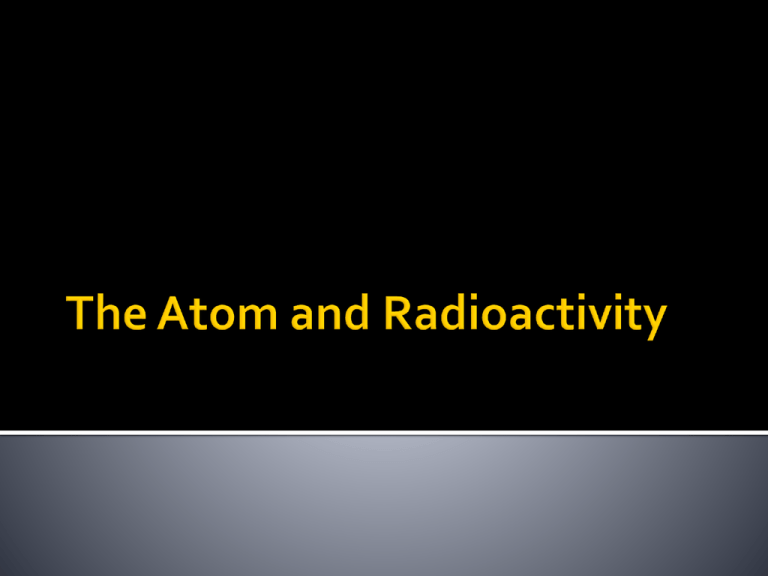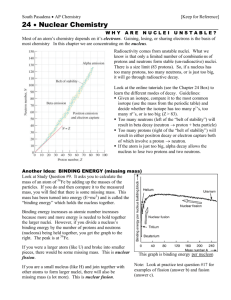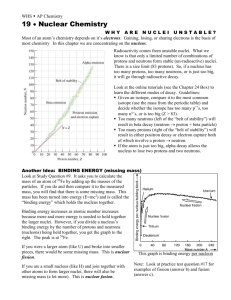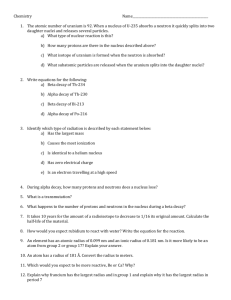The Atom and Radioactivity
advertisement

Good Afternoon! The SLO will be administered today in Earth Systems. All electronic devices have to be powered off and turned in during testing-policy Pencils are needed Do your best and take your time on each question! Assessments are used to measure learning growth throughout the course of the year SLO Completion Electronic devices turned in Read or unit 1 vocabulary crossword for students who are finished Talking is not an option-no disruptions to testing environment Atom – The smallest particle that has the properties of an element. Element – A substance that cannot be broken down into simpler substances. Atoms are tiny units that determine the properties of all matter. Atoms are made up of several different, smaller parts. We will focus on 3 – protons, neutrons and electrons. Electrons (e-) – negative charge Protons (p+) – positive charge Neutrons (no)– neutral charge The center of the atom is known as the nucleus. (Orange inner circle) The nucleus has a positive charge. The bulk of the mass of an atom is in its nucleus. It contains the protons and the neutrons. Outside the nucleus in orbitals are the electrons. The chart below summarizes the subatomic particles in terms of location, charge and mass. Notice the protons and neutrons make up the bulk of the mass of an atom. Particle/ Characteristic Location in the atom Proton p+ In the nucleus Neutron no In the nucleus Electron eOutside the nucleus in orbitals Charge Mass Positive None Approximately Approximately ½ mass of ½ mass of atom atom Negative Little to no mass The subatomic particles determine characteristics for elements including its identity, mass, and charge. The identity of an element is determined by the number of protons in the nucleus. Each element has a set number of protons. The atomic number of an element is equal to its number of protons. This atom has a total of 3 protons. Because it has 3 protons, this is lithium. If you look at the periodic table, you will notice the element with the atomic number of 3 is lithium. p+ p+ p+ no no no The sum of the number of protons and neutrons in the nucleus of the atom determines its mass. The sum is known as the mass number. On the periodic table, the atomic mass for an element is generally a decimal number because it is a weighted average of all the naturally occurring isotopes of that element. The mass number of this atom would be 6. Inside the nucleus there are 3 protons and 3 neutrons for a total of 6. When you look on the PT, you notice the atomic mass is 6.94. p+ p+ p+ no no no Isotopes are atoms of the same element that contain a different number of neutrons. Since the number of neutrons is different, the mass number will be different. The number of protons will be the same for isotopes because it is the identifying factor of the element. These are isotopes of lithium. Notice the left atom has a mass number of 5 and the right atom has a mass number of 6. Both still have 3 protons which means it is lithium. p+ p+ p+ no no p+ p+ p+ no no no C-14 The symbol of the element is written with the mass number behind it. 14 6 C The superscript represents the mass number and the subscript represents the atomic number of the element. Neutral atoms have no charge. This is because they have the same number of protons and electrons. Since they equal, the atomic number tells you both the number of protons and the number of electrons for a neutral atom. Element Protons Neutrons Electrons Mass # Atomic # Isotope symbol nitrogen 7 15-7=8 7 15 Nitrog en-15 106 150 Phosphorus Tungsten 84 7 http://app.discoveryeducation.com/search?Ntt=radioactive+decay Nuclei are held together by strong nuclear forces. These forces act over a short distance and are between the protons and neutrons in the nucleus of an atom. SNF help “hold” a nucleus together. Radioactivity is caused by an unstable nucleus. The nucleus is unstable because the ratio of protons to neutrons is lopsided. The process by which an unstable nucleus emits one or more particles or energy in the form of electromagnetic radiation. The particles or energy emitted is known as nuclear decay. During nuclear decay, atoms can be transformed into isotopes or into different elements. We will focus on 3 types of decay. Alpha Beta Gamma Definition Symbol Type of decay Mass and Charge Penetrating Power A positively charged particle emitted by certain radioactive nuclei, made up of two protons and two neutrons α or helium isotope Alpha Most massive type of decay and has a positive charge Does not travel well through particles because of its mass and charge. Cannot penetrate a piece of paper. Least harmful outside the body, most harmful inside the body An electron emitted by an unstable nucleus β or electron notation Beta Negative charge and little to no mass Travels farther than alpha particle because of less mass. Can penetrate paper but not a 3 mm piece of aluminum A penetrating form of radiation emitted by an unstable nucleus γ Gamma No charge and no mass Since there is no mass or charge, there is nothing “slowing” it down. Can penetrate up to 60 cm of aluminum or 7 cm of lead During alpha and beta decay, the number of protons or neutrons in an unstable nucleus changes. For alpha decay, the nucleus emits two protons and two neutrons. This is the equivalent of a helium atom and is 4 represented as 2 He For beta decay, an electron is emitted and is represented as 0 e 1 1. Evolution of the Universe Guided 2. Study Guide 3. Planet composition flipbook 4. Study of matter video notes 5. 12.3 Radioactive Dating (vocab & questions) 6. Atom structure guided notes 7. Isotope practice worksheet 8. Warm ups (9/2-9/5) notes Compare & contrast alpha and beta decay using notes from last week. Explain why both types of decay result in the formation of new elements. M&Mium Lab-bring a tear & share bag of plain M&Ms We can use this information to determine the new isotope or element formed when a nucleus undergoes decay. The process is very similar to a simple math problem. It is a matter of adding or subtracting. 4 2 A helium atom, He is always a product in alpha decay. When determining the other product, you determine the mass number by subtracting 4 from the mass number of the original isotope. To determine the atomic number, you subtract 2 from the original atomic number. Determine the symbol by looking on the PT. 226 88 Ra He Rn 4 2 222 86 1. Polonium-218 2. Radon-222 3. Plutonium-244 0 1 An electron, e is always a product in beta decay. To determine the other product, you use the same process as alpha decay. Notice the mass number for the product is the same as the original mass number. The atomic number is actually one higher than the original because you subtract a -1 from it, which is equivalent to adding +1. To determine the element, you would look on the PT. C e N 14 6 0 1 14 7 1. Bi-214 2. Fe-56 3. Pb-210 Compare & contrast alpha and beta decay-be specific Radioactive isotopes will continue to go through decay processes until the sample is no longer radioactive. Each radioactive isotope has a constant decay rate known as a half-life. Half-life – The time required for ½ of a radioactive sample to decay. Half-lives can last from nanoseconds to billions of years. Take out a sheet of NB paper Flatmium has a half life of 20 seconds. Fold the paper in half during the 20 second half life Crumple one half of the NB paper-new element Crumplium Continue radioactive decay Describe the process of radio active decay using your guided notes Explain how the Flatmium to Crumplium model illustrates radioactive decay & half life. Write the following equation for the alpha decay of Samarium-149 Write the following equation for the beta decay of Uranium-237 Introduction Mini-Chemistry Lesson Procedures 1.Brianna P, Taylor, TJ Daniel 2. Selvin, Urias, Vanessa 3. Demi, Megan,Tamara 4. Beth, Kaitlyn, Autumn 5. Miranda, Jesse, Ana 6. Koutlas,Cody, Bryannah, Logan 7. Kenneth, Montana, Marcus 1. 2. 3. 4. 5. 6. 7. 8. 9. 10. Kyle, Luke, C.J. Joe, Robert, Johnathan Martin, Meghan, Chase Emma, Shelly, Tim Kelsey, Jailene, Toney, Jesse, Katlyn, DaJour Zavier, Jordan, Siera, David Kenzey, Chris, Alex George, Vance, Blake Diana, Colton, Kain LaQuandre, Nicole, Jasmine 2. Seth, Hope, Olivia 3. Simon, Trilan, Isiah 4. Emmanuel, Laura, Lester 5. Tyrel, Terry L, Erik 6. Dakota, Christopher, Tyler T 7. Dylan, Briana, Trey 8. Brianna C, Bradley, Barbara 9. Tyler D, Brandon, Emily 10. Flori, Melissa, Ivone 11. Michelle, Cierra 1. Tell me if you are the ONLY person here in your group It is OKAY to have groups of 2 if someone is absent. 1. 2. 3. 4. 5. 6. 7. 8. Jessica, Branden, Sarah Kindal, Thomas J, Christopher Angelica, Zeke, Aaron Lamar, Trell, Molly Johnathen, Thomas N Phyllicia, Krysta, Elma Dillion, Savannah, T Padgett Megan, Hideah, Neydy Tell me if you are the ONLY person here in your group It is OKAY to have groups of 2 if someone is absent. Think-pair-share: Explain how this activity can be used to explain our current learning target: Students can explain the relationship between radioactive decay and half life. Writing prompt: Students explain the relationship between radioactive decay & half life. (paragraph) Refer to the Flatimum & Crumplium activity and the M&Mium Lab to compose your answer. Graph your data Answer discussion questions (lab groups) Half life reflection: Explain how the M&Mium lab helped or did not help you understand the relationship between half-life and radioactive decay 6. Radioactive guided notes Warm ups (9/8-9/12) M&Mium Lab Handout Half-life problems Isotopes & decay processes Unit 1 vocab crossword 7. NEED PERIODIC TABLE FOR QUIZ!! 1. 2. 3. 4. 5. Barium-122 has a half-life of 2 minutes. A fresh sample weighing 80 g was obtained. If it takes 10 minutes to set up an experiment using barium122, how much barium-122 will be left when the experiment begins? Warm Up Half life problems Notes Review of Radioactive decay Summarizer Writing prompt: Describe how radioactive decay is used to determine the age of rocks, fossils & solar system All living things are made of carbon and it exists as C-12 and C-14 (radioactive). The ratio of C-12 to C-14 in living things is a constant value. As things die, the C-14 begins to decay and the ratio changes. When “old” things are found, scientists can determine the ratio of C-12 to C-14 and the “age” of the fossil can be determined. Keep in mind, each time a sample goes through a half-life process, half of the sample will remain. In other words, after one half-life, half of the sample will remain. After a second half-life, ¼ of the sample will remain and so on. 1 sheet of paper Crossword completion (5 min) Radiometric Dating Video Clip (8 min) Preview of Radiometric Dating Activity Summarizer (10 min) Explain how the model simulates radioactive decay. Briefly explain how isotopes were used to calculate age of the fossil. Radium-226 has a half-life of 1599 years. How long would it take 7/8 of a radium-226 sample to decay? First you have to determine how many decays take place to get to 7/8. The first ½ life takes you to ½ the sample. Then it goes through another decay ( ½ of ½) to ¼. ¼ of the sample then goes through a ½ life decay to get 1/8 of the sample remaining or in other words, 7/8 of the sample has decayed. Summarizing: 1 ½ ¼ 1/8 Each arrow represents a ½ life. So the sample went through 3 decays. Each decay takes 1599 years. 3 x 1599 yrs = 4797 years. The ½ life of iodine-131 is 8.1 days. How long will it take for ¾ of a sample of iodine-131 to decay? 1½¼ 2 half-lives, so 2 x 8.1 = 16.2 days A sample of strontium-90 is found to have decayed to 1/8 of its original amount after 87.3 years. What is the ½ life of strontium90? Although this is not the same problem, all we do is work in reverse, in a way. We figure out how many decays the sample went through. 1 ½ ¼ 1/8 3 = 3 decays To get the length of each ½ life, take the total decay time, 87.3 yrs., and divide by the total number of decays. 87.3 years ÷ 3 = 29.1 years So each ½ life represents 29.1 years.








